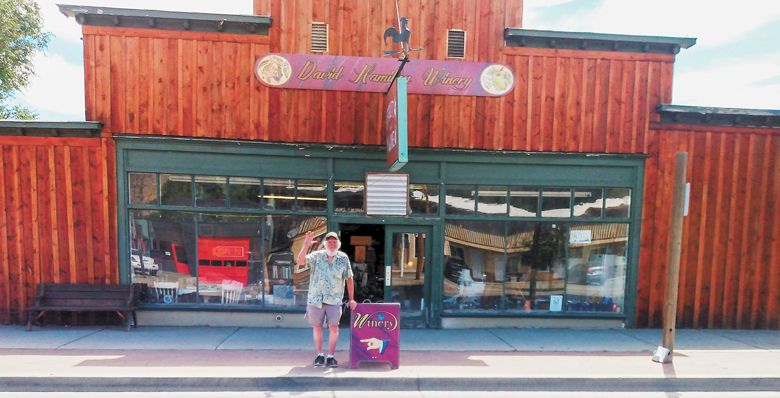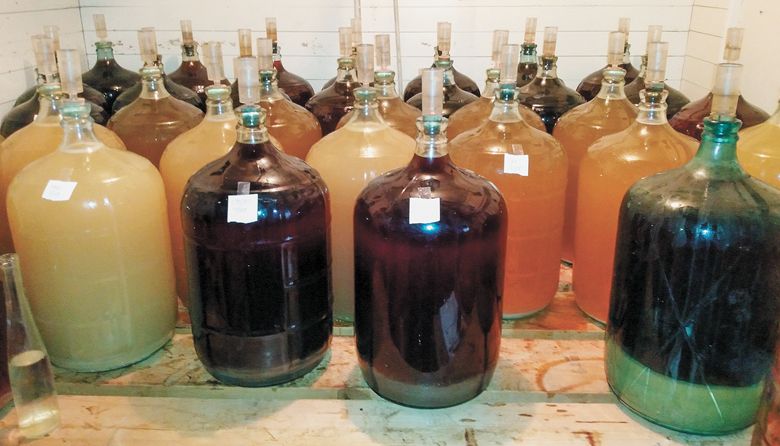Go (John) Day Drinking
David Hamilton Winery focuses on unique fruit wines


By Richard F. LaMountain
Seventy years ago, in Beaumont, Texas, beekeeper and amateur winemaker A.C. Bentley enlisted his nine-year-old grandson to help him vinify a small batch of blackberry wine.
Today, in remote Grant County, Oregon, that grandson, David Hamilton, maintains Bentley’s tradition crafting some of the most unique wines in the Beaver State.
Hamilton is a rural Renaissance man— as well as a winemaker, beekeeper, businessman, combat veteran, backgammon aficionado and mountain-man “buckskinner.” Friendly and gregarious, he’s always happy to share his wines and stories. (But don’t call him “sir.” “It’s like putting an elevator in an outhouse,” he says. “It just doesn’t fit.”)
FROM WAR TO WINE
After spending his childhood and teen years in Beaumont— during which Hamilton continued to help his grandfather make wine—he attended Baylor University in Waco. After graduation, Hamilton worked as a photographer for a Dallas public-relations firm.
Then, in 1966, “I got a letter in the mail that began, ‘Greetings,’” Hamilton recalls. “It was a draft notice. I really didn’t want to go, but my father insisted, escorting me to the induction center at the end of his shotgun.”
Assigned to the Army, “I spent the better part of a year in Vietnam,” says Hamilton. “I was a helicopter gunner in the Americal Division, 123rd Aviation Battalion and saw a lot of combat.”
After completing his two-year service, Hamilton returned home, taking possession of 200 bee colonies bequeathed to him by his grandfather. Soon afterward, “I put those bees in his old flatbed truck and drove to Washington state.” There, he worked as a beekeeper, built greenhouses for a nursery in Woodinville— and, most importantly, met Crish, who became his wife.
Another stop along the way included California, where Hamilton cultivated almonds and served on a helicopter firefighting crew. In the early 1990s, Hamilton and his wife moved to Grant County, where they’ve lived ever since. In 2000, Hamilton opened his eponymous David Hamilton Winery.
RURAL WINEMAKER
Originally located in a small Mt. Vernon building at the corner of Highways 26 and 395, the winery expanded, moving a block west, into the town’s sprawling, 125-year-old former mercantile. Hamilton produces and ages wines in the back rooms and corridors. And in the old store’s vast, unpartitioned retail space, visitors are welcomed into a tasting room replete with an eclectic, Old-West pastiche of antiques, old books and rocks and gems. Most weekends Hamilton— often ensconced in an old rocker beside a crackling woodstove— dispenses wine, quips and stories to customers and townspeople.
WILD FRUITS AND A FAMILY TRADITION
Most commercial wines are made from traditional wine grapes. However, Hamilton uses other fruits: blackberries, chokecherries, elderberries and raspberries (and one vegetable). He regularly picks fruits in the wild, often with family and friends. Hamilton started foraging in some of the Pacific Northwest’s most remote locales— including along Camas Creek in Oregon’s Central Cascades, in Washington’s Snoqualmie Valley, and at 4,000-to-5,000-foot elevations on the slopes of Mount Adams.
Fruit-picking remains the basis of a Hamilton family tradition. Every August, during Hamilton’s birthday week, close relatives gather between the Oxbow and Brownlee dams on the Oregon side of the Snake River. They camp, converse, eat, sing— and pick Hells Canyon wild plums. “Four kinds of wild plums grow there,” he explains, “yellow, yellow-red, red and black. The yellow and yellow-red ones I’ll mix 50-50 with organic blueberries.” The result is “what the majority of our customers think is our finest wine.”
Though Hamilton makes most of his wines from wild-picked fruits, in recent years he’s purchased some cultivated commercially, including blueberries and yellow shiro plums from organic growers in Idaho. Hamilton serves as his own grower for a personally meaningful wine— one dedicated to an old and dear friend.
TRIBUTE TO A FRIEND
Jimmy Allen was a Grant County resident who served as a U.S. Marine in Vietnam. When he returned, he worked 38 years for Chester’s, the county’s largest grocery, much of that time as manager of the meat department.
After Jimmy’s sudden death from an aneurysm, his wife gave Hamilton some of the rhubarb plants her husband cultivated. “I planted them on my property,” Hamilton recalls. “It took several years before they established themselves. Once they did, I started making Jimmy Allen Rhubarb Wine.” Given the tart, tangy vegetable from which it’s made, the wine tastes surprisingly sweet and mild, with a smooth, luscious mouthfeel and lingering finish. On every bottle, Jimmy’s photograph adorns the front label and his life story the back— “so people don’t forget him,” says Hamilton. “He was a good man.”
FRUIT-SWEET AND SULFITE-FREE
At the David Hamilton Winery, every stage of production maximizes the wines’ fresh-fruit flavor. Hamilton stresses that his wines are “fruit-sweet, not sugar-sweet.” To this end, he employs a number of strategies.
First, shortly after picking, Hamilton freezes his fruit. This step, he maintains, will extract more juice come press time.
Next, so as not to infuse the wines with tannins from skins and seeds— “they take away from the fruit flavor,” Hamilton maintains— he gently presses, rather than crushes, the fruit. And rather than using oak barrels, which also can add tannins, he ferments the musts in 55-gallon glass containers.
“My grandfather believed that the drier you make a fruit wine, the less fruit flavor you have,” remembers Hamilton. He adds organic sugar to his fermenting wines three times a day to ensure fruit-enhancing sweetness. After fermentation, Hamilton ages his wines in neutral stainless-steel barrels and five-gallon glass carboys, adding no sulfite to his wines. “So many people are allergic to sulfites,” he explains. “The majority of commercial winemakers believe they are necessary to give their wines a 25-to-30-year shelf life.”
Do Hamilton’s wines taste best immediately after bottling? “Not necessarily,” he says. “Aging helps everything . . . I’ve opened 25-year-old bottles of my huckleberry wine— that had no added sulfites— and it tasted wonderful.” Hamilton also recommends chilling his wines, which enhances the fruit flavor.
EFFECTS OF THE PANDEMIC
In its early years, the winery produced 1,500 gallons annually, most sold at Astoria’s and Newport’s annual food-and-wine festivals, along with other, similar events. But when COVID-19 hit, his income and production plummeted. Now Hamilton is ramped up again; last April, he was able to market his wines at the Astoria celebration for the first time since 2019.
MOUNTAIN MEN AND “SUMMER IN A BOTTLE
A key part of Hamilton’s identity— and his winery’s image— revolves around his devotion to the history and lifestyle of the 19th-century mountain man. For more than 50 years, he’s attended annual rendezvous of kindred souls spending several days in primitive campsites— wearing buckskin clothing, living in teepees, shooting black-powder rifles and reenacting the daily lives of the hardy, solitary pioneers who helped forge the American West.
In fact, a song written by one of his fellow “buckskinners” best conveys the essence of Hamilton’s wines. In “Winer’s Wine,” Paul Garrison (aka Dr. Mongo) sings of wines as capturing “summer in a bottle.” And that they do: fresh and simple, they capture the fun, carefree nature of the year’s sunniest season. They also exemplify the unpretentious manner of his fellow mountain men and his hardy Eastern Oregon neighbors.
Be it summer or any other time of year, Hamilton continues to hone the craft his grandfather taught him seven decades ago— from which he has built, and continues to build, one of Oregon’s most unique and interesting families of wines.








